|
Now that the U.S. election is over, investors — while keeping a wary eye on the development of the new administration — moved to closely monitor the OPEC decision-making process and react via crude prices. Politics is dominating Europe this weekend. By the end of this upcoming weekend (at this writing on Friday) we will know the results of the Italian constitutional referendum and Austrian election.
In November, the equity indexes followed here were split between gains and losses. Most of the emerging market indexes were down on worries that higher U.S. interest rates will drain capital spending from them. On the week, the indexes were mixed. Most economic data released during the week were positive.
 Crude oil prices soared after the Organization of the Petroleum Exporting Countries (OPEC) reached its first agreement to cut oil output since 2008. After months of wrangling in an effort raise prices and reassert the cartel's influence over a market increasingly dominated by the US, Russia and others, OPEC members agreed to cut production by 1.2 million barrels per day from the current 33.6 million barrels. This represents about 1 percent of global production. Other oil producers from outside the cartel are expected to cut an additional 600,000 barrels a day including half from Russia. OPEC members said they are targeting prices as high as $55 to $60 per barrel. That would boost petroleum dependent economies that have been badly damaged by two years of prices that have often sagged below $50 per barrel. The deal to cut production should help put a floor under prices even though investors are skeptical that the cuts can stick. Crude oil prices soared after the Organization of the Petroleum Exporting Countries (OPEC) reached its first agreement to cut oil output since 2008. After months of wrangling in an effort raise prices and reassert the cartel's influence over a market increasingly dominated by the US, Russia and others, OPEC members agreed to cut production by 1.2 million barrels per day from the current 33.6 million barrels. This represents about 1 percent of global production. Other oil producers from outside the cartel are expected to cut an additional 600,000 barrels a day including half from Russia. OPEC members said they are targeting prices as high as $55 to $60 per barrel. That would boost petroleum dependent economies that have been badly damaged by two years of prices that have often sagged below $50 per barrel. The deal to cut production should help put a floor under prices even though investors are skeptical that the cuts can stick.
| |
|
2015 |
2016 |
% Change |
|
Index |
Dec 31 |
Nov 25 |
Dec 2 |
Week |
Nov |
2016 |
| Asia/Pacific |
|
|
|
|
|
|
|
| Australia |
All Ordinaries |
5344.6 |
5570.5 |
5502.63 |
-1.2% |
1.8% |
3.0% |
| Japan |
Nikkei 225 |
19033.7 |
18381.2 |
18426.08 |
0.2% |
5.1% |
-3.2% |
|
Topix |
1547.30 |
1464.53 |
1477.98 |
0.9% |
5.5% |
-4.5% |
| Hong Kong |
Hang Seng |
21914.4 |
22723.5 |
22564.82 |
-0.7% |
-0.6% |
3.0% |
| S. Korea |
Kospi |
1961.3 |
1974.5 |
1970.61 |
-0.2% |
-1.2% |
0.5% |
| Singapore |
STI |
2882.7 |
2859.3 |
2919.37 |
2.1% |
3.2% |
1.3% |
| China |
Shanghai Composite |
3539.2 |
3261.9 |
3243.84 |
-0.6% |
4.8% |
-8.3% |
|
|
|
|
|
|
|
|
| India |
Sensex 30 |
26117.5 |
26316.34 |
26230.66 |
-0.3% |
-4.6% |
0.4% |
| Indonesia |
Jakarta Composite |
4593.0 |
5122.1 |
5245.96 |
2.4% |
-5.0% |
14.2% |
| Malaysia |
KLCI |
1692.5 |
1627.3 |
1628.96 |
0.1% |
-3.2% |
-3.8% |
| Philippines |
PSEi |
6952.1 |
6889.8 |
6886.74 |
0.0% |
-8.4% |
-0.9% |
| Taiwan |
Taiex |
8338.1 |
9159.1 |
9189.49 |
0.3% |
-0.5% |
10.2% |
| Thailand |
SET |
1288.0 |
1500.4 |
1501.66 |
0.1% |
1.0% |
16.6% |
|
|
|
|
|
|
|
|
| Europe |
|
|
|
|
|
|
|
| UK |
FTSE 100 |
6242.3 |
6840.8 |
6730.72 |
-1.6% |
-2.5% |
7.8% |
| France |
CAC |
4637.1 |
4550.3 |
4528.82 |
-0.5% |
1.5% |
-2.3% |
| Germany |
XETRA DAX |
10743.0 |
10699.3 |
10513.35 |
-1.7% |
-0.2% |
-2.1% |
| Italy |
FTSE MIB |
21418.4 |
16515.1 |
17086.85 |
3.5% |
-1.1% |
-20.2% |
| Spain |
IBEX 35 |
9544.2 |
8674.4 |
8607.10 |
-0.8% |
-5.0% |
-9.8% |
| Sweden |
OMX Stockholm 30 |
1446.8 |
1491.2 |
1470.08 |
-1.4% |
2.4% |
1.6% |
| Switzerland |
SMI |
8818.1 |
7881.5 |
7784.01 |
-1.2% |
0.6% |
-11.7% |
|
|
|
|
|
|
|
|
| North America |
|
|
|
|
|
|
|
| United States |
Dow |
17425.0 |
19152.1 |
19170.42 |
0.1% |
5.4% |
10.0% |
|
NASDAQ |
5007.4 |
5398.9 |
5255.65 |
-2.7% |
2.6% |
5.0% |
|
S&P 500 |
2043.9 |
2213.4 |
2191.95 |
-1.0% |
3.4% |
7.2% |
| Canada |
S&P/TSX Comp. |
13010.0 |
15075.4 |
15052.52 |
-0.2% |
2.0% |
15.7% |
| Mexico |
Bolsa |
42977.5 |
45357.9 |
44555.260 |
-1.8% |
-5.7% |
3.7% |
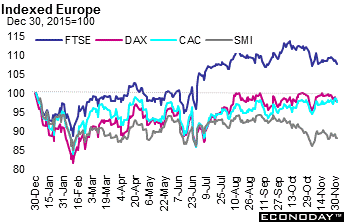 Equity indexes were mostly lower last week with only the MIB advancing 3.5 percent. Traders were cautious before this weekend's key events. The Italian constitutional referendum will take place on Sunday, along with elections in Austria. On the week, the FTSE was down 1.6 percent, the CAC declined 0.5 percent, the DAX lost 1.7 percent and the SMI retreated 1.2 percent. Friday's daily losses were pared after the positive U.S. employment report. In Europe, only the CAC (up 1.5 percent), OMX (up 2.4 percent) and SMI (up 0.6 percent) advanced in November. The FTSE lost 2.5 percent in November while the DAX, MIB, and IBEX declined 0.2 percent, 1.1 percent and 5.0 percent respectively. Equity indexes were mostly lower last week with only the MIB advancing 3.5 percent. Traders were cautious before this weekend's key events. The Italian constitutional referendum will take place on Sunday, along with elections in Austria. On the week, the FTSE was down 1.6 percent, the CAC declined 0.5 percent, the DAX lost 1.7 percent and the SMI retreated 1.2 percent. Friday's daily losses were pared after the positive U.S. employment report. In Europe, only the CAC (up 1.5 percent), OMX (up 2.4 percent) and SMI (up 0.6 percent) advanced in November. The FTSE lost 2.5 percent in November while the DAX, MIB, and IBEX declined 0.2 percent, 1.1 percent and 5.0 percent respectively.
There were no surprises in the final manufacturing PMI report for November which confirmed the flash estimate of 53.7 and was up from October's final print of 53.5. The minor improvement in activity rates (34-month highs) reflected another respectable increase in manufacturing production and the steepest rise in new orders since February 2014. Exporters had a particularly good month with the rate of growth of new business hitting a 33-month peak. Regionally, the best performer was the Netherlands (57.0) ahead of Austria (55.4) and Spain (54.5). All three countries saw multi-month highs. Germany (54.3) similarly had a decent month but Italy (52.2) and France (51.7) continued to underperform.
The Italian referendum
Italian Prime Minister Matteo Renzi has pledged to resign in the event of a "no vote" on the December 4th constitutional reform referendum. The latest opinion polls show a notable lead for the 'no' vote camp. Renzi is staking his political future on this referendum that would change the Italian constitution by weakening the upper house of parliament and strengthening the central government. With plans to revise almost a third of the entire Italian Constitution, PM Renzi, the principal architect and Europhile, is essentially seeking the complete overhaul the country's political system. The goal is to diminish the power of the Senate (PM Renzi actually wanted to abolish it altogether) by reducing the number of senators from 315 to just 100.
Mr Renzi has indicated that should he lose, he would stand down ahead of the next scheduled general election in 2018. This effectively makes it a vote of confidence and rejection would duly generate a new parliamentary crisis in Italy and add to creeping international doubts about Italy's capacity to remain a member of the Eurozone over the longer-term. In addition to any political fallout, a no vote could have serious implications for Italy's fragile banking industry where non-performing loans are ominously high and reform and consolidation dangerously overdue.
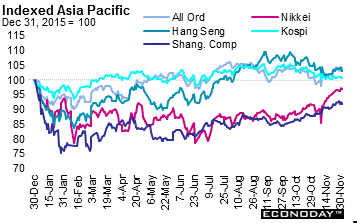 Equities in the Asia Pacific region ended the week on a mixed note in choppy trading. Stocks gyrated during the week on crude oil prices that fluctuated with investor sentiment regarding a production cut by OPEC and non-OPEC oil producers. Wednesday's pact to reduce crude output removed the market's uncertainty over oil. However investors continued to parse through economic data for clues on the prospects for higher U.S. interest rates. The key U.S. employment report was released after markets here were closed for the week. Also in focus is the weekend's vote in Italy on constitutional reform. Equities in the Asia Pacific region ended the week on a mixed note in choppy trading. Stocks gyrated during the week on crude oil prices that fluctuated with investor sentiment regarding a production cut by OPEC and non-OPEC oil producers. Wednesday's pact to reduce crude output removed the market's uncertainty over oil. However investors continued to parse through economic data for clues on the prospects for higher U.S. interest rates. The key U.S. employment report was released after markets here were closed for the week. Also in focus is the weekend's vote in Italy on constitutional reform.
Treasury yields continued their climb reflecting expectations that inflation will accelerate in 2017. This in turn triggered fresh concerns about capital outflows from emerging Asian markets. For the week, gains ranged from 0.1 percent (SET and KLCI) to 2.4 percent (Jakarta Composite). Losses ranged from 0.2 percent (Kospi) to 1.2 percent (All Ordinaries).
The November monthly changes reflect in part the reaction to the U.S. election results and concerns over rising sovereign debt yields worldwide. The Nikkei and Topix duplicated their October results with above 5 percent monthly gains. This time, the Nikkei added 5.1 percent after 5.9 percent while the Topix was up 5.5 percent after 5.3 percent. However, both indexes continue to be lower for the year. Contributing to the equity gains was the plunge in the yen. The Shanghai Composite was up for a second month, this time by 4.8 percent but is lower for 2016. The All Ordinaries added 1.8 percent in November and continues to be positive in 2016.
Better Chinese data also helped boost consumer sentiment. November CFLP manufacturing PMI climbed to 51.7 from 51.2 in October, showing expansion for the fourth straight month. The latest reading marks the highest level seen since July 2014. The CFLP non-manufacturing PMI rose to 54.7 from 54 in October. However, the Caixin manufacturing PMI declined to 50.9 from 51.2 in October. It stayed out of contractionary territory for a fifth straight month.
The Sensex tumbled 4.6 percent with a number of factors contributing to its retreat. The twin shocks on November 8 of Donald Trump's U.S. election victory and Indian Prime Minister Narendra Modi's currency crackdown unleashed a wave of selling in stock and foreign exchange markets. Mr Modi announced plans to replace India's largest denomination bank notes with newly designed ones in an effort to clamp down on corruption, thwart counterfeiters and fight tax evasion. Foreign investors have pulled $2.6 billion out of Indian shares in November, compared with a net investment of $7 billion between January and October, according to Indian regulatory data. Many investors believe the currency crackdown will prove wise in the long run, by reducing corruption and increasing tax collections, and that the Trump shock won't be long-lasting. Investors will learn the Reserve Bank of India's reaction on Tuesday when it announces its policy decision.
 The U.S. dollar softened during the week and was down against all of its major counterparts with the exception of the yen. The currency retreated against the euro, pound sterling, Swiss franc and the Canadian and Australian dollars. The U.S. currency ended the week on a down note after the November employment report indicated that wages slipped even though the employment increase met expectations and the unemployment rate skidded to 4.6 percent, the lowest level in nine years. The report confirmed expectations for an interest rate increase on December 14. The U.S. dollar softened during the week and was down against all of its major counterparts with the exception of the yen. The currency retreated against the euro, pound sterling, Swiss franc and the Canadian and Australian dollars. The U.S. currency ended the week on a down note after the November employment report indicated that wages slipped even though the employment increase met expectations and the unemployment rate skidded to 4.6 percent, the lowest level in nine years. The report confirmed expectations for an interest rate increase on December 14.
The pound sterling continues to react to comments from officials regarding Brexit. The currency rallied last week as investors seized on comments that there was a possibility that the UK might retain preferential access to the European market after Brexit. The currency has tumbled since the June 23 referendum results.
|
|
2015 |
2016 |
% Change |
|
|
Dec 31 |
Nov 25 |
Dec 2 |
Week |
2016 |
| U.S. $ per currency |
|
|
|
|
|
|
| Australia |
A$ |
0.7288 |
0.744 |
0.745 |
0.1% |
2.2% |
| New Zealand |
NZ$ |
0.6833 |
0.704 |
0.714 |
1.3% |
4.4% |
| Canada |
C$ |
0.7231 |
0.740 |
0.753 |
1.8% |
4.1% |
| Eurozone |
euro (€) |
1.0871 |
1.059 |
1.066 |
0.7% |
-1.9% |
| UK |
pound sterling (£) |
1.4742 |
1.248 |
1.272 |
2.0% |
-13.7% |
|
|
|
|
|
|
|
| Currency per U.S. $ |
|
|
|
|
|
|
| China |
yuan |
6.4937 |
6.919 |
6.880 |
0.6% |
-5.6% |
| Hong Kong |
HK$* |
7.7501 |
7.756 |
7.756 |
0.0% |
-0.1% |
| India |
rupee |
66.1537 |
68.473 |
68.225 |
0.4% |
-3.0% |
| Japan |
yen |
120.2068 |
113.220 |
113.660 |
-0.4% |
5.8% |
| Malaysia |
ringgit |
4.2943 |
4.458 |
4.453 |
0.1% |
-3.6% |
| Singapore |
Singapore $ |
1.4179 |
1.427 |
1.421 |
0.4% |
-0.2% |
| South Korea |
won |
1175.0600 |
1177.300 |
1172.550 |
0.4% |
0.2% |
| Taiwan |
Taiwan $ |
32.8620 |
31.908 |
31.891 |
0.1% |
3.0% |
| Thailand |
baht |
36.0100 |
35.629 |
35.588 |
0.1% |
1.2% |
| Switzerland |
Swiss franc |
1.0014 |
1.0141 |
1.0107 |
0.3% |
-0.9% |
| *Pegged to U.S. dollar |
|
|
|
|
|
|
| Source: Bloomberg |
|
|
|
|
|
|
 Eurozone inflation provisionally crept a tick higher in line with expectations this month. At 0.6 percent, the flash annual rate has now risen for three consecutive months and stands at its highest mark since April 2014. Excluding energy & unprocessed food, the yearly HICP weighed in at 0.8 percent. The narrower core measure, which omits energy, food, alcohol & tobacco, again held at the 0.8 percent mark. Amongst the major components, inflation was up 0.3 percentage points at 0.7 percent for food, drink & tobacco but flat at 0.3 percent for non-industrial goods and similarly unchanged at 1.1 percent in services. At minus 1.1 percent after minus 0.9 percent, the rate in energy decreased for the first time since July. Eurozone inflation provisionally crept a tick higher in line with expectations this month. At 0.6 percent, the flash annual rate has now risen for three consecutive months and stands at its highest mark since April 2014. Excluding energy & unprocessed food, the yearly HICP weighed in at 0.8 percent. The narrower core measure, which omits energy, food, alcohol & tobacco, again held at the 0.8 percent mark. Amongst the major components, inflation was up 0.3 percentage points at 0.7 percent for food, drink & tobacco but flat at 0.3 percent for non-industrial goods and similarly unchanged at 1.1 percent in services. At minus 1.1 percent after minus 0.9 percent, the rate in energy decreased for the first time since July.
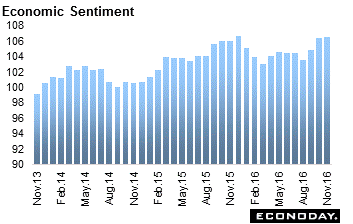 November EU Commission's measure of economic sentiment (ESI) was essentially stable at 106.5, 0.1 point firmer than its minimally upward revised October reading but still at its highest level since last December. This was the ESI's third consecutive monthly rise. The stability of the headline measure masked a significant improvement in consumer confidence (confirmed up 1.9 points at its provisional minus 6.1) as well as increases in both the retail sector (1.5 after 0.4) and construction (minus 12.7 after minus 14.2). However, gains here were offset by the first worsening in industrial sentiment in three months (minus 1.1 after minus 0.6). Services (12.1) were unchanged. For the larger member states, the national ESI rose 1.5 points to 103.2 in France and 0.8 points to 108.4 in Spain. Germany (108.0 after 108.7) and Italy (104.2 after 105.0) suffered modest losses. November EU Commission's measure of economic sentiment (ESI) was essentially stable at 106.5, 0.1 point firmer than its minimally upward revised October reading but still at its highest level since last December. This was the ESI's third consecutive monthly rise. The stability of the headline measure masked a significant improvement in consumer confidence (confirmed up 1.9 points at its provisional minus 6.1) as well as increases in both the retail sector (1.5 after 0.4) and construction (minus 12.7 after minus 14.2). However, gains here were offset by the first worsening in industrial sentiment in three months (minus 1.1 after minus 0.6). Services (12.1) were unchanged. For the larger member states, the national ESI rose 1.5 points to 103.2 in France and 0.8 points to 108.4 in Spain. Germany (108.0 after 108.7) and Italy (104.2 after 105.0) suffered modest losses.
 October retail sales excluding autos rebounded strongly with a hefty 2.4 percent jump on the month following a marginally sharper revised 1.5 percent tumble in September. Unadjusted annual growth was down 1.0 percent, 0.6 percent lower than the month before but negatively biased by workday effects. October's monthly increase was the steepest in more than five years and suggests that the continued buoyancy of consumer confidence is now beginning to manifest itself more fully in terms of actual spending. October retail sales excluding autos rebounded strongly with a hefty 2.4 percent jump on the month following a marginally sharper revised 1.5 percent tumble in September. Unadjusted annual growth was down 1.0 percent, 0.6 percent lower than the month before but negatively biased by workday effects. October's monthly increase was the steepest in more than five years and suggests that the continued buoyancy of consumer confidence is now beginning to manifest itself more fully in terms of actual spending.
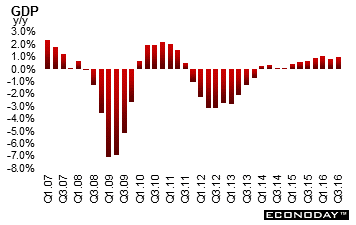 Third quarter gross domestic product was up an unrevised 0.3 percent on the quarter and 1.0 percent when compared with the same quarter a year ago. The major GDP expenditure components showed a modest 0.1 percent quarterly rise in consumer spending and a more impressive 0.8 percent increase in fixed investment. Machinery was up 0.7 percent and transportation surged 8.8 percent but construction fell 0.2 percent. Government final expenditure increased 0.2 percent. The external balance had a negative impact as exports grew just 0.1 percent on the quarter and imports rose 0.7 percent. Third quarter gross domestic product was up an unrevised 0.3 percent on the quarter and 1.0 percent when compared with the same quarter a year ago. The major GDP expenditure components showed a modest 0.1 percent quarterly rise in consumer spending and a more impressive 0.8 percent increase in fixed investment. Machinery was up 0.7 percent and transportation surged 8.8 percent but construction fell 0.2 percent. Government final expenditure increased 0.2 percent. The external balance had a negative impact as exports grew just 0.1 percent on the quarter and imports rose 0.7 percent.
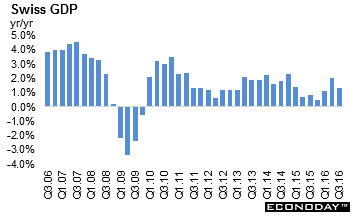 Economic growth as measured by gross domestic product unexpectedly ground to a halt in the July to September quarter. Following an unrevised 0.6 percent quarterly rise in the previous period, total output was unchanged — its weakest performance since it last contracted back in the first quarter of 2015. Annual growth was 1.3 percent, down from 2.0 percent. Stagnation reflected a small increase in domestic demand and a negative contribution from net external trade. In particular, private consumption was up just 0.1 percent from the second quarter when it showed no growth at all. Investment held up rather better with equipment and software as well as construction gaining 0.5 percent but government consumption was down 0.1 percent. The headline data would have looked worse but for a 0.2 percentage point contribution from inventory accumulation. Exports of goods excluding valuables dropped 0.2 percent for a second successive quarter while their imports increased 0.2 percent. Exports of services were off 0.8 percent and imports of services were flat. Economic growth as measured by gross domestic product unexpectedly ground to a halt in the July to September quarter. Following an unrevised 0.6 percent quarterly rise in the previous period, total output was unchanged — its weakest performance since it last contracted back in the first quarter of 2015. Annual growth was 1.3 percent, down from 2.0 percent. Stagnation reflected a small increase in domestic demand and a negative contribution from net external trade. In particular, private consumption was up just 0.1 percent from the second quarter when it showed no growth at all. Investment held up rather better with equipment and software as well as construction gaining 0.5 percent but government consumption was down 0.1 percent. The headline data would have looked worse but for a 0.2 percentage point contribution from inventory accumulation. Exports of goods excluding valuables dropped 0.2 percent for a second successive quarter while their imports increased 0.2 percent. Exports of services were off 0.8 percent and imports of services were flat.
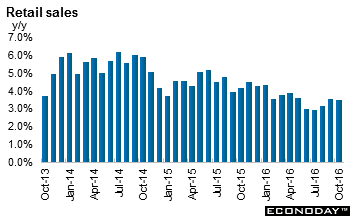 October retail sales were up 0.5 percent on the month and 3.5 percent from the same month a year ago. Headline growth was driven food retailing (up 0.6 percent), household goods retailing (up 0.7 percent), other retailing (up 0.8 percent) and cafes, restaurants & takeaway food services (up 0.4 percent). These gains were offset by lower sales for clothing, footwear & personal accessory retailing (down 0.4 percent) and department stores (down 0.4 percent). Sales were up in most Australian states and territories with Queensland and Victoria seeing the biggest gains of 0.8 percent and 0.5 percent respectively. October retail sales were up 0.5 percent on the month and 3.5 percent from the same month a year ago. Headline growth was driven food retailing (up 0.6 percent), household goods retailing (up 0.7 percent), other retailing (up 0.8 percent) and cafes, restaurants & takeaway food services (up 0.4 percent). These gains were offset by lower sales for clothing, footwear & personal accessory retailing (down 0.4 percent) and department stores (down 0.4 percent). Sales were up in most Australian states and territories with Queensland and Victoria seeing the biggest gains of 0.8 percent and 0.5 percent respectively.
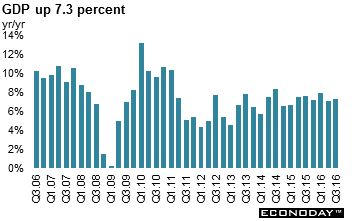 Gross domestic product for the three months to September increased 7.3 percent when compared with the same three months a year ago. Second quarter GDP increased 7.1 percent. GDP has grown between 7.0 percent and 8.0 percent on the year since the start of 2015. The increase in GDP growth was primarily driven by private final consumption spending, which saw an increase from 6.7 percent to 7.6 percent in the three months to September. Investment spending however dropped 5.6 percent on the year after declining 3.1 percent in the three months to June. Annual growth in government consumption remained strong but slowed from 18.8 percent to 15.2 percent. Gross domestic product for the three months to September increased 7.3 percent when compared with the same three months a year ago. Second quarter GDP increased 7.1 percent. GDP has grown between 7.0 percent and 8.0 percent on the year since the start of 2015. The increase in GDP growth was primarily driven by private final consumption spending, which saw an increase from 6.7 percent to 7.6 percent in the three months to September. Investment spending however dropped 5.6 percent on the year after declining 3.1 percent in the three months to June. Annual growth in government consumption remained strong but slowed from 18.8 percent to 15.2 percent.
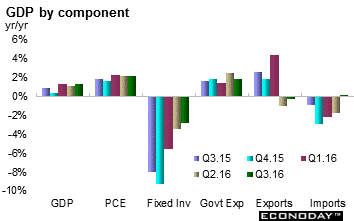 Third quarter real gross domestic product was up 0.9 percent following a 0.3 percent decline in the second quarter. GDP was up at an annualized pace of 3.5 percent. Exports of energy products rebounded from a second quarter decline, boosting growth. Domestic demand decelerated to a 0.2 percent gain. Exports increased 2.2 percent, making up some ground lost in the second quarter (down 3.9 percent). Growth was driven by a 6.1 percent increase in the energy sector, following a 5.1 percent decline in the second quarter as a result of the Fort McMurray wildfires. Household final consumption expenditures were up 0.6 percent, a similar pace to the previous two quarters. Growth was mainly in services (0.9 percent). Expenditures on goods increased 0.3 percent despite a 0.6 percent decline in spending on durables, particularly motor vehicles. Investment in residential structures (down 1.4 percent) was down for the first time since the first quarter of 2014. Government final consumption expenditure declined 0.3 percent following a 1.3 percent increase in the second quarter. Business investment on machinery and equipment fell 3.2 percent in the third quarter, while intellectual property products declined 4.5 percent on reduced investment in mineral exploration and evaluation (down 26.3 percent). Investment in non-residential structures rose 3.7 percent, largely due to the import of a module destined for the Hebron offshore oil project in Newfoundland and Labrador. Third quarter real gross domestic product was up 0.9 percent following a 0.3 percent decline in the second quarter. GDP was up at an annualized pace of 3.5 percent. Exports of energy products rebounded from a second quarter decline, boosting growth. Domestic demand decelerated to a 0.2 percent gain. Exports increased 2.2 percent, making up some ground lost in the second quarter (down 3.9 percent). Growth was driven by a 6.1 percent increase in the energy sector, following a 5.1 percent decline in the second quarter as a result of the Fort McMurray wildfires. Household final consumption expenditures were up 0.6 percent, a similar pace to the previous two quarters. Growth was mainly in services (0.9 percent). Expenditures on goods increased 0.3 percent despite a 0.6 percent decline in spending on durables, particularly motor vehicles. Investment in residential structures (down 1.4 percent) was down for the first time since the first quarter of 2014. Government final consumption expenditure declined 0.3 percent following a 1.3 percent increase in the second quarter. Business investment on machinery and equipment fell 3.2 percent in the third quarter, while intellectual property products declined 4.5 percent on reduced investment in mineral exploration and evaluation (down 26.3 percent). Investment in non-residential structures rose 3.7 percent, largely due to the import of a module destined for the Hebron offshore oil project in Newfoundland and Labrador.
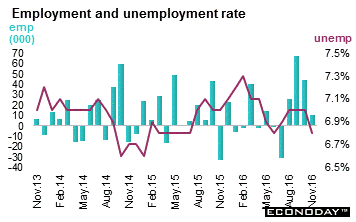 November employment gains eased to an increase of 10,700 – expectations were for no change after two months of notable increases. With fewer people searching for work, the unemployment rate fell by 0.2 percentage points to 6.8 percent. The participation rate declined to 65.6 from 65.8 in October. November's increase was once again led by part-time employment, which rose 19,400 after a 67,100 jump the previous month, perhaps indicative of ongoing business uncertainty. More people were employed in the finance, insurance, real estate & leasing industry (up 14,000), in information, culture & recreation (up 13,000), in the "other services" industry (up 11,000) and in agriculture (up 6,000). On the other hand, employment declined in construction (down 14,000), manufacturing (down 12,000) along with transportation and warehousing (down 9,700). There were 31,000 fewer self-employed workers in November, while the number of employees was little changed in both the public and private sectors. November employment gains eased to an increase of 10,700 – expectations were for no change after two months of notable increases. With fewer people searching for work, the unemployment rate fell by 0.2 percentage points to 6.8 percent. The participation rate declined to 65.6 from 65.8 in October. November's increase was once again led by part-time employment, which rose 19,400 after a 67,100 jump the previous month, perhaps indicative of ongoing business uncertainty. More people were employed in the finance, insurance, real estate & leasing industry (up 14,000), in information, culture & recreation (up 13,000), in the "other services" industry (up 11,000) and in agriculture (up 6,000). On the other hand, employment declined in construction (down 14,000), manufacturing (down 12,000) along with transportation and warehousing (down 9,700). There were 31,000 fewer self-employed workers in November, while the number of employees was little changed in both the public and private sectors.
Equities were mixed both on the week and in November. Globally, a majority of the economic data released during the week were positive, indicating a pick-up in growth especially in the U.S. and Canada. However, a flat quarter in Switzerland surprised on the down side. Globally, manufacturing PMIs climbed further above the breakeven 50 line. The U.S. dollar was mostly lower on the week while the pound sterling and euro were higher. As we begin a round of central bank meetings over the next two weeks, investors will closely parse the individual statements as they assess prospects for 2017.
| Central Bank activities |
|
| Dec 6 |
Australia |
Reserve Bank of Australia Monetary Policy Announcement |
| Dec 7 |
Canada |
Bank of Canada Monetary Policy Announcement |
|
India |
Reserve Bank of India Monetary Policy Announcement |
| Dec 8 |
Eurozone |
European Central Bank Monetary Policy Announcement |
| |
|
|
| The following indicators will be released this week... |
| Europe |
|
|
| Dec 5 |
Eurozone |
Composite and Services PMI (November) |
|
|
Retail Sales (October) |
|
Germany |
Composite and Services PMI (November) |
|
France |
Composite and Services PMI (November) |
|
UK |
Services PMI (November) |
| Dec 6 |
Eurozone |
Gross Domestic Product (Q3.2016 final) |
|
Germany |
Manufacturing Orders (October) |
| Dec 7 |
Germany |
Industrial Production (October) |
|
France |
Merchandise Trade Balance (October) |
|
UK |
Industrial Production (October) |
|
|
Halifax House Price Index (November) |
| Dec 9 |
Germany |
Merchandise Trade Balance (October) |
| |
|
|
| Asia Pacific |
|
|
| Dec 5 |
Japan |
Services PMI (November) |
| Dec 7 |
Australia |
Gross Domestic Product (Q3.2016) |
| Dec 8 |
Japan |
Gross Domestic Product (Q3.2016 second estimate) |
|
Australia |
Merchandise Trade Balance (October) |
|
China |
Merchandise Trade Balance (November) |
| Dec 9 |
China |
Consumer Price Index (November) |
|
|
Producer Price Index (November) |
| |
|
|
| Americas |
|
|
| Dec 6 |
Canada |
International Trade (October) |
Anne D Picker is the author of International Economic Indicators and Central Banks.
|

